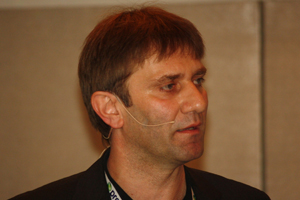Liquid prestarters in the spotlight at Provimi symposium

The second day of the Provimi animal nutrition seminar in Barcelona, Spain, mainly focused on prestarter feed for piglets – and how this can promote pig performance in later life.
The pig event on November 14 closed off a two-day event in Spain. Simultaneously also sessions for poultry and cattle were held.
Prof Dr Georg Dusel, University of Applied Sciences, Bingen, Germany, spoke at the start of the swine related sessions and touched on various problems that people can see occurring in breeding farms – and he formulated practical ways to improve economics in piglet rearing, by introducing five goals.
• Reducing pre-weaning and rearing mortality to <10%
• Perinatal sow feeding strategy to reach vital sows and vital piglets
• High sow milk yield for best performance of suckling piglets
• High and stable feed intake in lactating sow feeding
• Cost-optimised feed formulation for rearing piglets based on net energy and SID amino acids
Especially his comments on high sow milk were interesting. Recent research by Dusel (2011) focused on the composition of sow milk – and found that a high variability exists between sows. The difference could be up to 7-9 kg per sow.
Dr Ruurd Zijlstra, University of Alberta, Canada spoke twice. His first presentation touched on the history of milk replacers, and showed early attempts to combine early weaning with liquid prestarters. Provimi’s current product of RescueDecks in combination with RescueMilk makes use of knowledge of earlier projects in the past.
There is definitely potential for the concept, he said. He noted that piglets are capable of growing at faster rates than achieved when they are kept with the sow.
His second presentation focused on co-products as alternative feed ingredients – an earlier article was published in Pig Progress on this topic.
Dr Simon Tibble, global species technology specialist, swine at Cargill, then emphasised the importance of a ‘golden start’. No phase in a pigs’ life, he said is as important as the weaner phase. A good feed conversion in the weaner phase, he said, leads to a good conversion in the finishing phase.
He also pointed to the fact that he observed that funny enough it often are weaner pigs who initiate feeding post-weaning. The smaller an lighter pigs usually take less time post-weaning to initiate feeding – mostly because they have not been so dependent on milk.
Dr Lia Hoving, Provimi and Prof Bas Kemp, Wageningen University, the Netherlands, jointly presented their research on how a lactation phase has an influence on the next gestation and gestation phase. Also, it was shown how to learn to eat like piglets – and how young piglets can be encouraged to start to eat earlier e.g. by applying scent and by observing how their mothers ate.
Dr Douglas Cook, Cargill, also spoke at this swine seminar. In a presentation strongly focused on nutritionists, he focused on practical ways to reduce feed costs and increase output in pig production.
Read more here about the first day of the seminar.











